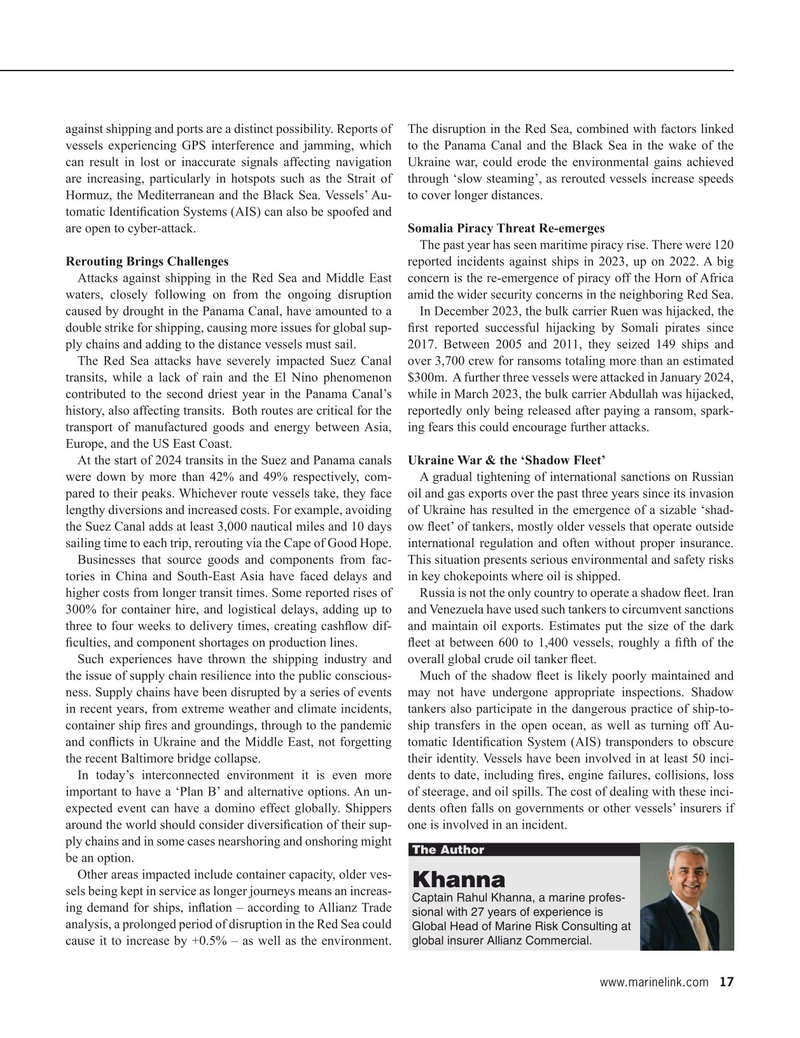
Page 17: of Maritime Reporter Magazine (June 2024)
Read this page in Pdf, Flash or Html5 edition of June 2024 Maritime Reporter Magazine
against shipping and ports are a distinct possibility. Reports of The disruption in the Red Sea, combined with factors linked vessels experiencing GPS interference and jamming, which to the Panama Canal and the Black Sea in the wake of the can result in lost or inaccurate signals affecting navigation Ukraine war, could erode the environmental gains achieved are increasing, particularly in hotspots such as the Strait of through ‘slow steaming’, as rerouted vessels increase speeds
Hormuz, the Mediterranean and the Black Sea. Vessels’ Au- to cover longer distances. tomatic Identi? cation Systems (AIS) can also be spoofed and are open to cyber-attack. Somalia Piracy Threat Re-emerges
The past year has seen maritime piracy rise. There were 120
Rerouting Brings Challenges reported incidents against ships in 2023, up on 2022. A big
Attacks against shipping in the Red Sea and Middle East concern is the re-emergence of piracy off the Horn of Africa waters, closely following on from the ongoing disruption amid the wider security concerns in the neighboring Red Sea. caused by drought in the Panama Canal, have amounted to a In December 2023, the bulk carrier Ruen was hijacked, the double strike for shipping, causing more issues for global sup- ? rst reported successful hijacking by Somali pirates since ply chains and adding to the distance vessels must sail. 2017. Between 2005 and 2011, they seized 149 ships and
The Red Sea attacks have severely impacted Suez Canal over 3,700 crew for ransoms totaling more than an estimated transits, while a lack of rain and the El Nino phenomenon $300m. A further three vessels were attacked in January 2024, contributed to the second driest year in the Panama Canal’s while in March 2023, the bulk carrier Abdullah was hijacked, history, also affecting transits. Both routes are critical for the reportedly only being released after paying a ransom, spark- transport of manufactured goods and energy between Asia, ing fears this could encourage further attacks.
Europe, and the US East Coast.
At the start of 2024 transits in the Suez and Panama canals Ukraine War & the ‘Shadow Fleet’ were down by more than 42% and 49% respectively, com- A gradual tightening of international sanctions on Russian pared to their peaks. Whichever route vessels take, they face oil and gas exports over the past three years since its invasion lengthy diversions and increased costs. For example, avoiding of Ukraine has resulted in the emergence of a sizable ‘shad- the Suez Canal adds at least 3,000 nautical miles and 10 days ow ? eet’ of tankers, mostly older vessels that operate outside sailing time to each trip, rerouting via the Cape of Good Hope. international regulation and often without proper insurance.
Businesses that source goods and components from fac- This situation presents serious environmental and safety risks tories in China and South-East Asia have faced delays and in key chokepoints where oil is shipped.
higher costs from longer transit times. Some reported rises of Russia is not the only country to operate a shadow ? eet. Iran 300% for container hire, and logistical delays, adding up to and Venezuela have used such tankers to circumvent sanctions three to four weeks to delivery times, creating cash? ow dif- and maintain oil exports. Estimates put the size of the dark ? culties, and component shortages on production lines. ? eet at between 600 to 1,400 vessels, roughly a ? fth of the
Such experiences have thrown the shipping industry and overall global crude oil tanker ? eet. the issue of supply chain resilience into the public conscious- Much of the shadow ? eet is likely poorly maintained and ness. Supply chains have been disrupted by a series of events may not have undergone appropriate inspections. Shadow in recent years, from extreme weather and climate incidents, tankers also participate in the dangerous practice of ship-to- container ship ? res and groundings, through to the pandemic ship transfers in the open ocean, as well as turning off Au- and con? icts in Ukraine and the Middle East, not forgetting tomatic Identi? cation System (AIS) transponders to obscure the recent Baltimore bridge collapse. their identity. Vessels have been involved in at least 50 inci-
In today’s interconnected environment it is even more dents to date, including ? res, engine failures, collisions, loss important to have a ‘Plan B’ and alternative options. An un- of steerage, and oil spills. The cost of dealing with these inci- expected event can have a domino effect globally. Shippers dents often falls on governments or other vessels’ insurers if around the world should consider diversi? cation of their sup- one is involved in an incident.
ply chains and in some cases nearshoring and onshoring might
The Author be an option.
Other areas impacted include container capacity, older ves-
Khanna sels being kept in service as longer journeys means an increas-
Captain Rahul Khanna, a marine profes- ing demand for ships, in? ation – according to Allianz Trade sional with 27 years of experience is analysis, a prolonged period of disruption in the Red Sea could
Global Head of Marine Risk Consulting at global insurer Allianz Commercial. cause it to increase by +0.5% – as well as the environment. www.marinelink.com 17
MR #6 (1-17).indd 17 6/4/2024 9:15:27 AM

 16
16

 18
18
